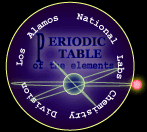

| Atomic Number: | 99 |
Atomic Radius: | ~186 pm | ||
| Atomic Symbol: | Es |
Melting Point: | 860 �C | ||
| Atomic Weight: | 252 |
Boiling Point: | -- | ||
| Electron Configuration: | [Rn]7s25f11 |
Oxidation States: | 3, 2 |
(Albert Einstein) Einsteinium, the seventh transuranic element of the actinide series to be discovered, was identified by Ghiorso and co-workers at Berkeley in December 1952 in debris from the first large thermonuclear explosion, which took place in the Pacific in November, 1952. The 20-day 253Es isotope was produced.
In 1961, enough einsteinium was produced to separate a macroscopic amount of 253Es. This sample weighted about 0.01Mg and was measured using a special magnetic-type balance. 253Es so produced was used to produce mendelevium (Element 101).
About 3Mg of einsteinium has been produced at Oak Ridge National Laboratories by
The targets were then removed for chemical separation of the einsteinium from californium.
Fourteen isotopes of einsteinium are now recognized. 254Es has the longest half-life (275 days).
Tracer studies using 253Es show that einsteinium has chemical properties typical of a heavy trivalent, actinide element.
Title Picture: Albert Einstein

Sources: CRC Handbook of Chemistry and Physics and the American Chemical Society.
Last Updated: 12/15/2003,� Chemistry Operations
Operated by the University
of California for the US Department
of Energy
|
Help
| Copyright � UC 2003 | Disclaimer